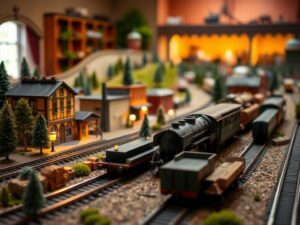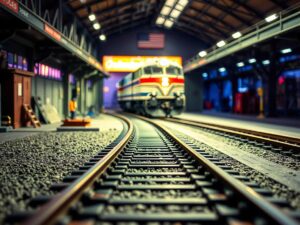How to Plan an Industrial Layout in HO Scale
How to Plan an Industrial Layout in HO Scale
How to Plan an Industrial HO Scale Layout
Howdy fellow railfans! Welcome back to the blog. Today, we’re diving headfirst into a fascinating world: building industrial HO scale layouts.
Think towering factories humming with activity, freighters rumbling past, and dedicated spurs weaving through meticulously detailed yards. Industrial layouts capture the heart of the rail industry’s vital role in our world. They offer incredible storytelling potential and allow for diverse scenery elements that cater to a wide range of modeling interests.
Why Choose an Industrial Layout?
Industrial layouts are perfect for those who crave a different kind of railroading experience. Unlike pastoral scenes with endless stretches of farmland, industrial tracks pulsate with the energy of industry and commerce. You can model everything from bustling freight yards to lumber mills and mines, each teeming with activity. And don’t underestimate the joy of weathering down buildings, aging equipment, and painting realistically grimy ground surfaces â there’s something uniquely satisfying about it!
Understanding the Basics: What Makes an Industrial Layout?
A truly successful industrial layout revolves around a few key components:
- Industries: The stars of the show! From massive factories and towering grain elevators to smaller workshops and sawmills, these buildings drive your layout’s theme and story.
-
Dedicated Spur Lines: These branch tracks connect directly to each industry, allowing for specific car handling and enhancing operational realism. Dedicated spurs add a unique element compared to simpler branch line layouts.
-
Switching Focus: Unlike passenger lines that follow established schedules, industrial layouts emphasize the dynamic process of freight switching â organizing cars, assembling trains, and preparing them for their journeys. This requires creative track planning and a love for maneuvering locomotives in confined spaces.
Planning Your Layout: Where to Begin?
Let’s get down to brass tacks! Hereâs a step-by-step guide to get your wheels turning:
1. Conceptualization: Find Your Niche.
Think about the kind of industrial scene that truly captures your imagination:
-
Railroad Operations: Focus on a specific operation like a major freight yard, a lumber yard with loading ramps and a train shed, or a coal transfer point.
-
Region-Specific Industries: Embrace the regional flavor! Research the types of industries prevalent in your chosen location â textile mills in New England, steel plants in Pennsylvania, fruit orchards in California, or logging camps in the Pacific Northwest.
2. Size and Space Considerations:
Realistically assess the space you have available. Remember:
* Smaller layouts can focus on detail and micro-industry representation.
* Larger layouts allow for greater operational complexity and multiple industries within a defined region.
Don’t forget about the need to access all areas of your layout for maintenance and model operation!
3. Track Planning â The Backbone of Your Layout.
The key is to prioritize switching movements. Design:
-
Interconnecting Tracks: Allow cars to be moved between industries and staging yards seamlessly.
-
Passing Sidings: Enable efficient two-way traffic on single-track spurs.
- Main Line(s): Determine if you’ll include mainline operations or focus solely on the switching scene within your industrial complex.
Online planning tools like Anyrail can be invaluable for visualizing track arrangements.
4. Scenery and Industrial Touches: Bringing It All to Life
An essential ingredient of a successful industrial layout!
-
Materials Palette: Embrace realism! Rusty iron, weathered concrete, aged timber â the look of these materials conveys the stories of work and industry.
-
Factory Building Variety: Avoid generic buildings; aim for authentic details like brickwork, pipework, ventilation shafts, loading docks, and office windows to showcase the functions within each structure.
-
**Ground Texture:
Don’t just settle for green turf! Explore different ground textures like gravel pads around industrial areas, dusty roadsides near loading zones, and even subtle drainage ditches or puddles reflecting rain-washed surfaces.
5. Operational Flow – The Heart of Your Layout.
Plan realistic operational scenarios:
* Shift Work Cycles: Consider multiple “shifts” within a day, allowing for switching movements, deliveries, and train arrivals and departures to add variety and simulate the hustle and bustle.
- Yard Tracks Assignments: Assign specific roles to different tracks within your yard â storage track, sorting yard, incoming car park, outgoing line â this adds operational realism.
Let’s Explore Specific Industry Models: Inspiration Awaits!
- Grain Elevators: Imagine massive grain bins rising towards the sky, conveyors transporting bounty, and loading ramps bustling with activity. Add details like scales, silos, and farm wagons for extra realism.
-
Foundries: The molten metal furnace glows hot â smoke plumes rise from chimney stacks, workers move about on catwalks, and giant cranes lift weighty slabs of iron.
-
Coal Handling Plants: This is where it gets dusty! Massive hoppers are fed by rail cars loaded with coal. You can include belts transporting coal to storage areas, trucks ready for transport, and conveyor systems leading to a nearby power plant.
Advanced Tips: Elevating Your Industrial Layout
- Lighting Design: Use a combination of natural light sources (overhead skylights) and warm incandescent bulbs for factories and outdoor scenes.
-
Sound Effects: Immerse your model world with authentic industrial sounds! Look for recordings of switching locomotives, clanging hammers in foundries, or the rumble of loading machinery â they’ll add incredible atmosphere to your layout.
-
Digitizing Operations (Optional): Advanced modelers can use software like Rocrail or JMRI to control their layouts digitally, track car movement, and even run simulations.
Insights for Future Industrialists:
-
Start Small, Think Big: Itâs tempting to plan a sprawling mega-industrial scene right off the bat â start with a compact layout focusing on one or two key industries, and expand it over time!
-
**Embrace Collaboration: Thereâs no need to go solo. Connect with fellow hobbyists online or locally for inspiration, shared ideas, and even potential construction help.
Remember, model railroading is about the journey as much as the destination. Enjoy the planning process, don’t be afraid to experiment, and most importantly â have fun!
Your Turn!
Let me know in the comments below:
What kind of industrial layout do you dream of creating?
Which specific industries capture your interest the most?
Happy building, everyone!




